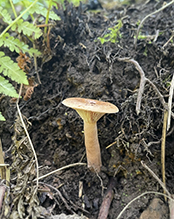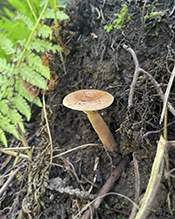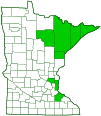Curry Milkcap
(Lactarius camphoratus)
Conservation • Description • Habitat • Ecology • Distribution • Taxonomy
Conservation Status |
|
|||||||
| IUCN Red List | not listed |
|||||||
| NatureServe | not listed |
|||||||
| Minnesota | not listed |
|||||||
Description |
||
Curry Milkcap is an edible, small to medium-sized, gilled mushroom. It occurs in Europe and North America. In the United States it occurs in the eastern mixed forests from Maine to Florida, west to Minnesota and Missouri. Disjunct populations have been recorded in northern Colorado around Denver, northern Washington around Seattle, and northern California around San Francisco. It is uncommon in Minnesota, where it reaches the western extent of its range. It is found in spring, summer, and fall, alone, scattered, or in groups but not clustered (gregarious). It grows on the ground attached to the roots of both hardwood and conifer trees. It has a mutually beneficial relationship (mycorrhizal) with the tiny rootlets of trees, absorbing sugars and amino acids while helping the tree absorb water. When it first appears, the cap is convex and dark reddish-brown. The upper surface may be moist or dry and is sometimes covered with a fine dust-like powder. There is usually a sharp, raised point (papilla) in the middle. As it ages the cap expands and the color fades. The mature cap is ⅝″ to 1¾″ (1.5 to 4.5 cm) in diameter, broadly convex on top and flat below (plano-convex), and depressed in the center. The papilla often persists. The upper surface is reddish-brown or orangish-brown in the center, fading to pale pinkish near the margin. The margin is sometimes scalloped or lined on older specimens. The gills are closely spaced or crowded, and are broadly attached to the stalk, sometimes slightly running down the stalk. They are whitish to pale pinkish at first, becoming reddish to cinnamon brown with age. They do not have stains from the latex. The stalk is hollow, fragile, ⅝″ to 2⅜″ (1.5 to 6.0 cm) long, and ⅛″ to ½″ (3 to 13 mm) thick, more or less the same thickness from top to bottom. It is the same color as the cap but becomes paler near the top with age. It is mostly smooth but may have hairs near the base. It does not have “potholes”. A fresh mushroom will exude a milky latex when sliced. This is best seen by slicing the gills near the stalk. The latex is white and milky at first, becoming thin and watery white (whey-like) with age. It does not stain white paper yellow. The flesh is hard, brittle, and pale cinnamon to white. It has a mild or slightly bitter taste, and a burnt sugar or maple-like odor when fresh, but a stronger curry-like odor when it dries. This is the feature that gives the mushroom its common name. It is edible, but it closely resembles other species whose edibility is unknown. The spore print is pale yellow or whitish. |
||
Similar Species |
||
Habitat and Hosts |
||
Hardwood and conifer trees |
||
Ecology |
||
Season |
||
Spring, summer, and fall |
||
Distribution |
||||
|
Sources |
|||
| 1/17/2023 | ||||
Occurrence |
||||
Uncommon in Minnesota |
||||
Taxonomy |
|||
| Kingdom | Fungi (Fungi) | ||
| Subkingdom | Dikarya | ||
| Phylum | Basidiomycota (Basidiomycete Fungi) | ||
| Subphylum | Agaricomycotina (Higher Basidiomycetes) | ||
| Class | Agaricomycetes (Mushrooms, Bracket Fungi, Puffballs, and Allies) | ||
| Subclass | Agaricomycetidae | ||
| Order | Russulales | ||
| Family | Russulaceae (milkcaps, brittlegills, and allies) | ||
| Genus | Lactarius (common milkcaps) | ||
Subgenus |
Russularia | ||
| Section | Olentes | ||
The common name Candy Cap has been applied to three closely related edible milkcap mushrooms, Lactarius camphoratus, L. fragilis, and L. rubidus. They are sometimes treated as a species complex. |
|||
Synonyms |
|||
Agaricus camphoratus Agaricus cimicarius Galorrheus camphoratus Lactarius cimicarius Lactarius terryi Lactifluus camphoratus Lactifluus terryi |
|||
Common Names |
|||
Curry Milkcap Curry-scented Milkcap |
|||
Glossary
Mycorrhizal
A symbiotic, usually beneficial relationship between a fungus and the tiny rootlets of a plant, usually a tree.
Papilla
On plants: A tiny, rounded, nipple-like projection on the surface of a leaf or petal. On mushrooms: A small, raised, sharply pointed projection on the cap above the point of attachment with the stalk.
Visitor Photos |
|||||
Share your photo of this fungus. |
|||||
| This button not working for you? Simply email us at info@MinnesotaSeasons.com. Attach one or more photos and, if you like, a caption. |
|||||
Honey Fae (Farah) |
|||||
 |
 |
||||
MinnesotaSeasons.com Photos |
|||||
|
|||||

Slideshows |
||

Visitor Videos |
|||
Share your video of this fungus. |
|||
| This button not working for you? Simply email us at info@MinnesotaSeasons.com. Attach a video, a YouTube link, or a cloud storage link. |
|||
Other Videos |
|||
| 4K Lactarius camphoratus Mushroom Identification Ultimate Mushroom |
|||
About
Jan 8, 2023 Text Mushroom Identification: https://ultimate-mushroom.com/edible/232-lactarius-camphoratus.html |
|||
| Curry Milkcap Fungus (Lactarius camphoratus) - Nature Insights Roger Griffith |
|||
About
Jul 28, 2016 The Curry Milkcap grows in pine and deciduous woods in summer and autumn. Being a milkcap it exudes milky fluid (lactates) if the gills are broken. A smell of curry pervades the dry milk and cap. Edible and used as a flavouring in powdered form. |
|||

Created: 1/17/2023
Last Updated:


